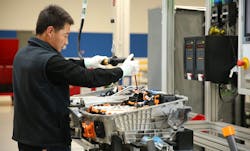Engineers not only need knowledge of the basics but also application-specific expertise. That’s especially true for power-supply engineers. The reality is that very few are doing “blank page” designs of sophisticated supply topologies. Instead, they are relying heavily on reference designs from IC vendors. Still, there are vital skills needed by today’s power engineers. Among them are the ability to deal with:
1) High voltages and/or high currents. Take voltage first: low voltage is the trend, with rails in the single digits. But in the real world of power transmission, motors, battery-powered vehicles and more, potentials of tens, hundreds, and even thousands of volts are common. Thus, knowledge of safety regulations and mandates, including creep and clearage, are critical.
It’s the same for the current side. Even if the components currents are low, board- and system-level currents of tens and hundreds of amps are often the norm. Designers need to quantify IR loss in connectors, contacts, busbars, PC board traces, and any conductor carrying those currents.
2) Mechanical and thermal issues. A power supply is much more than the physical implementation of a schematic diagram, no matter how perfect that schematic may be. There are issues of PC board material and thickness, and copper-cladding thickness as starters. Then there are considerations for proper mounting of larger, higher-power active and passive components (many of which are not surface-mount and require through holes, clamps, and other restraints). If these are ignored, a supply may work on the bench but fail after some real-world stresses.
Further, a credible thermal model must be developed and assessed for the supply and its heat sources. Paths for convention and conduction must be allocated and analyzed, so that a design’s total heat load is moved from sources to sinks.
3) Multirail operation. Systems now have multiple voltage rails, often differing by only a few tenths of a volt. How do you develop these multiple DC sources? Via a single controller IC with multiple outputs, or fully independent supplies? In addition to the obvious issues of nominal voltage, tolerance, regulation, and transient response required for each, proper power-up/down timing and sequencing within the group must be defined and assured.
4) Testing and EMI/RFI mandates. Interpreting which ones apply and how, and deciding how to meet them, is a major issue. How will you test to see if the design can be certified? Designers will likely need to be familiar with electronic loads that can be programmed to simulate the static and dynamic aspects of the actual load. Further, many supplies are galvanically isolated, so measuring key currents and voltages takes care because connecting a test instrument’s “ground” lead to the wrong point can defeat the isolation and even damage the supply.
5) Modeling. From a high-level perspective, a power supply is an amplifier, albeit a specialized one. Basic DC performances and all losses - both electrical and thermal - must be assessed in advance, since changes to the BOM or layout usually becomes a ripple-effect situation. Dynamic performance, including the effect of parasitics, and must also be modeled to avoid potential oscillation or instability while providing the required transient performance.
6) Finally, willing to challenge conventional wisdom. Yes, everyone “knows” that switching supplies are more efficient than linear ones, but that’s not necessarily always the case. In the region below 1 A, an LDO may have comparable or even better efficiency, plus lower total cost and fewer issues.
At the other end of the power spectrum, digital supplies using firmware-based algorithms rather than complex analog circuits may offer great benefits and flexibility at medium- and higher-operation. What does going digital do that was difficult or impossible to do previously?
Those who say, “it’s no big deal, it’s just a cookbook power-supply design,” are either battle-hardened designers or naïve newcomers. The increasing demands on today’s supplies for high performance and increased efficiency means that supply engineers must bring the right tools and attitude to both the overall design and the execution.
About the Author

Bill Schweber
Contributing Editor
Bill Schweber is an electronics engineer who has written three textbooks on electronic communications systems, as well as hundreds of technical articles, opinion columns, and product features. In past roles, he worked as a technical website manager for multiple topic-specific sites for EE Times, as well as both the Executive Editor and Analog Editor at EDN.
At Analog Devices Inc., Bill was in marketing communications (public relations). As a result, he has been on both sides of the technical PR function, presenting company products, stories, and messages to the media and also as the recipient of these.
Prior to the MarCom role at Analog, Bill was associate editor of their respected technical journal and worked in their product marketing and applications engineering groups. Before those roles, he was at Instron Corp., doing hands-on analog- and power-circuit design and systems integration for materials-testing machine controls.
Bill has an MSEE (Univ. of Mass) and BSEE (Columbia Univ.), is a Registered Professional Engineer, and holds an Advanced Class amateur radio license. He has also planned, written, and presented online courses on a variety of engineering topics, including MOSFET basics, ADC selection, and driving LEDs.
